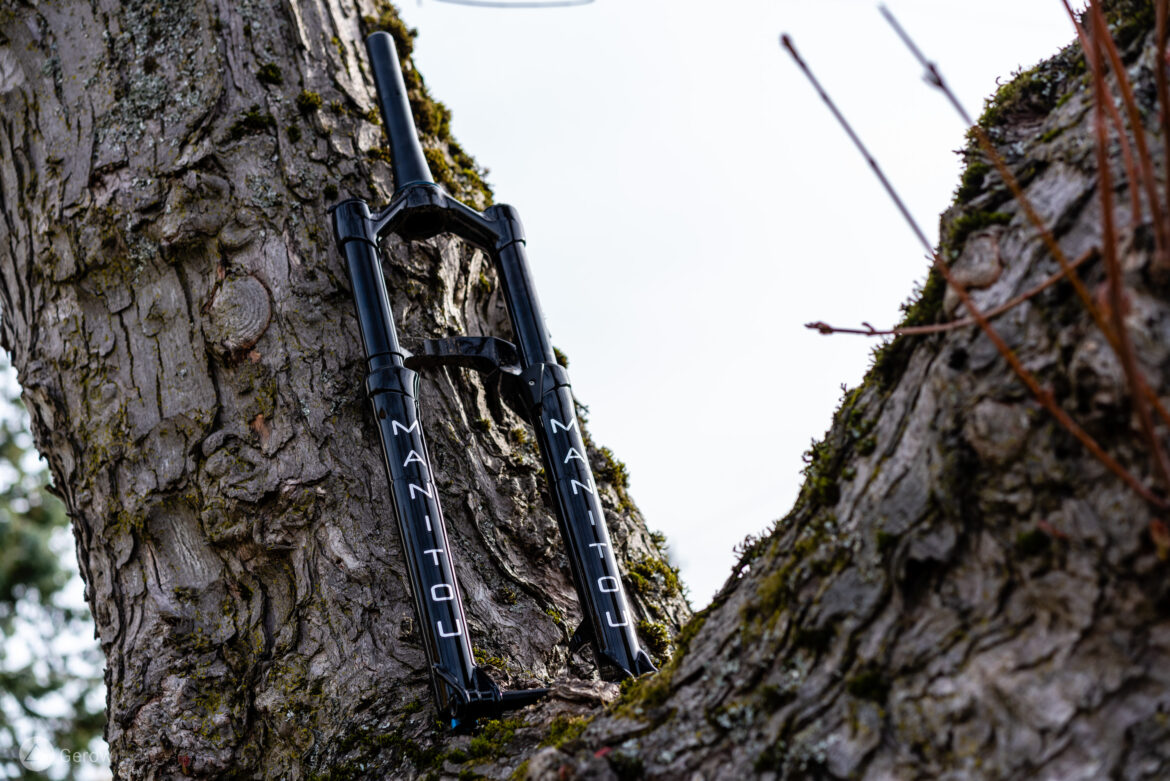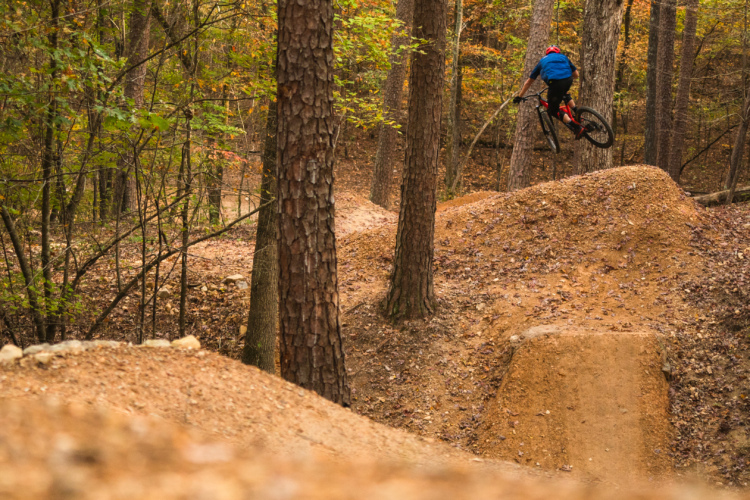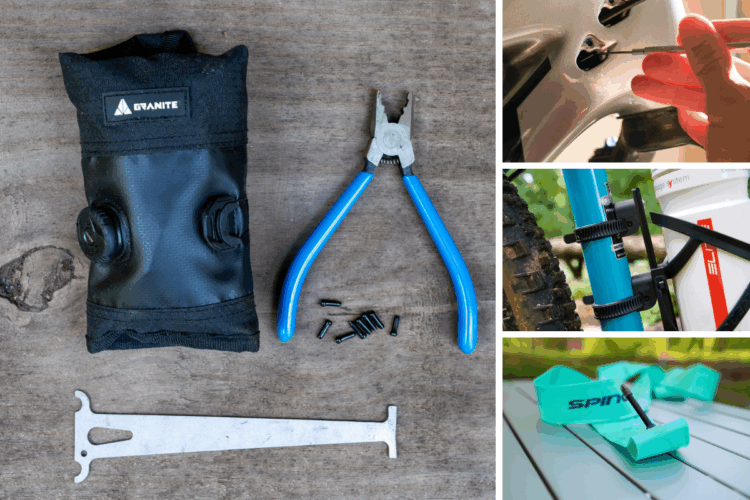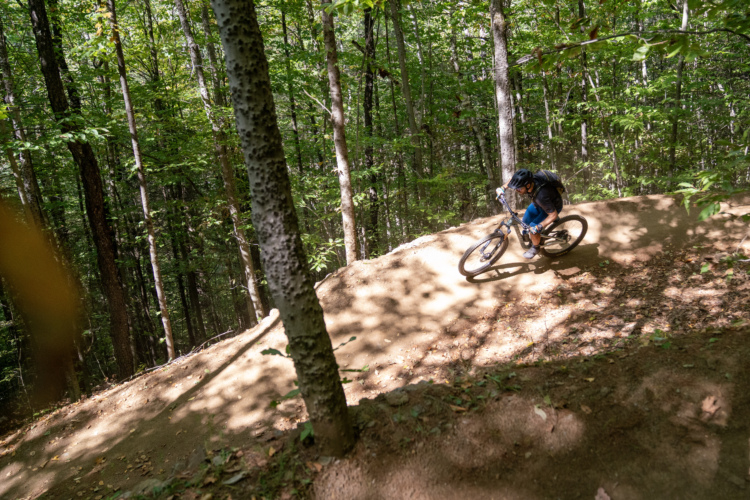
Pendulums that hang above mountain bike racing components can swing between moving poles, with their energy forever lurching toward speed and efficiency. In the pit below a 100 to 120mm race-fork pendulum, there are conflicting arguments between designing for comfort or all-out throttle. Occasionally a short-travel squisher accommodates both of those perspectives, allowing riders to choose precisely how the front of their bike behaves. The Manitou R7 Expert is one such versatile set of stanchions, with volume spacers for the positive and negative air spring to dial in performance.
Test pilot profile height: 175cm (5’9″) weight: 65kg (145lb) testing zone: Bellingham, Washington
Manitou R7 Expert chassis
Two R7 models sit in Manitou’s XC race segment and this lower-cost Expert model retails for $819 (available at Amazon and Wiggle) while the Pro model kicks the price ball up to $980. Manitou says the Pro model weighs 165g less, achieved via higher-grade alloy stanchions and some damper differences. With the steerer cut, a bearing race and star-fangled-nut installed, and some PNW mud caked into the arch, the R7 Expert 29er fork with 120mm of travel weighs 1,861g.
Like most XC forks, the R7 models use 32mm stanchions that offer the shorter lever just the right amount of flex and rigidity. I ran a 2.5″ tire between the arch and wasn’t able to flex the tire into the lowers no matter how hard I tried. With lighter and less rigid XC wheels that might have been a different story, but most XC racers are going to use narrower tires that leave a larger gap between the aluminum tubes and rubber tread, rendering this point moot.
Below those stanchions, Manitou’s well-known reverse arch is said to add 13% stiffness over a fork with similar intentions and a forward arch. They report that the added stiffness comes from a shorter arch that allows for stiffness characteristics similar to those in a larger sanctioned model.
The downside of that reversed arch is that its rearward reliefs pack with mud and it ends up weighing significantly more out on the trail. There is a “fender” to cover those reliefs on the arch, and it’s about as useful as strapping a thin chunk of milk carton to the fork. As with the Manitou Mezzer Pro we tested a while back, the fender sits too close to the tire, rubbing constantly on the 29×2.5″ tread to the point that I had to remove it, and the fender material is so flimsy that when it’s not rubbing knobs it hits the tire with every impact. There isn’t enough space beneath the arch to mount a different fender, so if your trails run well in the mud you’ll need a downtube fender and/or big-ass-glasses. Manitou says the fork should fit 29-inch tires up 68mm (2.6″) wide, though likely not with the fender installed.

I may be alone here, but I don’t grasp the advantages of the axle in this fork. Why add complexity to something that can otherwise be a super lightweight bolt and replaceable integrated nut? Maybe it’s thought to provide a faster mid-race wheel swap? The Hexlock axle has to be slid through in a specific position, and it doesn’t turn in the fork. Instead, an integrated nut on the non-drive side turns to pull it into a final resting position. This system works fine, but it seems needlessly over-engineered. It also adds one more place on the bike you can’t let dirt enter. If you’re repairing a front flat you’ll need to keep the axle and fork away from the soil that could collect on the threads and cause problems. This is true for any axle, but with the closed end of this system, you’ll want to be particularly cautious.
Manitou R7 Expert forks come in 27.5″ or 29″ sizes, with 100 or 120mm of travel and all of the standard crown offsets. The brake caliper mount fits a 160mm rotor, and the fork can work with up to a 203mm disc with an adaptor.
Air spring considerations

Travel on the R7 models can be adjusted internally, and I found the service documentation on Manitou’s site easy to follow. Theoretically, you could mount the R7 on a trail bike at 120mm, then swap it to the XC race ride with 100mm in a matter of minutes. That’s not a job every home mechanic has time for, but options are always rad to have.
Expert models use a balancing valve to equalize the positive and negative chambers. Manitou says “This gives the spring rate a consistent feel without any flat or dead spots in the stroke, along with giving riders of different weights the same initial stroke feel.” This system is fairly common, and it makes for an easily adjustable spring with only one chamber to manage when setting sag and looking for the desired amount of support.
In practice, the fork’s air spring is somewhat anemic out of the box, and racers searching for support will need to make some simple adjustments. I had the fork pumped up near its maximum pressure, with the compression halfway closed, and I couldn’t glimpse the level of support I would want for a legit XC race. This factor alone might justify upgrading to the R7 Pro model that offers additional air spring and damper adjustment.

You can purchase the Incremental Volume Adjust kit for an additional $55. This air spring comes stock on the Pro model, offering volume spacer swaps so you can dial in the progressivity throughout the R7 stroke. The kit takes a few minutes to install and makes a massive difference in the way the fork performs. It allowed for a far higher level of mid and end stroke and support that makes the R7 notably more racey. I would happily line up for an XC race or blast into inappropriately burly trails on this fork after adding the kit.
Initial stroke with the IVA remains supple enough to maintain traction just as well as any competing forks. With better seals and bushings most forks seem to have sorted out stiction, leaving us with suspension that starts out smooth and creates solid grip. I didn’t feel any bushing play in the fork throughout testing, and the crown remains creak-free. These things have really improved over the past decade.
Damper download

“We sorta get to use French” might have been a phrase heard in the Manitou office when they decided to call the R7’s damper “VTT,” or Variable Terrain Tune. The VTT offers a simple three-position compression lever with a fully open, firmer, and fully locked setting. The lockout does create a rigid front end, and the firm setting is perfect for rougher tracks with larger impacts in store. I found the open position a little underdamped and chose not to use it much. The damper employs a pair of shim stacks that Manitou says “By controlling the shim stack through which the oil flow is diverted we can manipulate the characteristic of the damper to be Lock-out, Digressive, or progressive to meet the demands of the rider and terrain.”
In terms of both high- and low-speed compression, the R7 Expert tune is now the lighter side, and there’s a good chance the brand’s World Cup athletes aren’t running this stock shim configuration. Here again, the R7 Pro model comes with a more adjustable damper on the compression end, allowing for both high- and low-speed tuning. The skip in this record is singing “just buy the Pro model”.

Regulating the fork’s return to full extension seems pretty dialed, with a fairly broad range of useable adjustments. I like my hardtail fork fairly fast, and this one will get there. One massive face plant of the R7 Expert rebound is that there are no detents in the knob, leaving riders with no precise way to judge where their rebound is in relation to where it was. This element is a deal-breaker for me, as I want to be able to dial my suspension in and be able to compare it, and periodically check that it’s in the correct position. If you’re comfortable with damper-knob ambiguity, this one should be fine.
Pros and cons of the Manitou R7 Expert fork
Pros
- Great support with the air spring upgrade
- Relatively lightweight
Cons
- Unusable fender
- No detents on the rebound knob
Summation
The R7 Expert with an IVA air spring upgrade is a great fork at around the same price of a Fox Performance Elite model. If you’re looking for something a little different looking it will certainly provide. I would suggest upgrading to the Pro model for far more adjustability and support unless your pendulum is staunchly swung toward the comfort side. Edgar Allen Poe might be stoked that this fork looks dark and slightly quirky, or maybe he’d be pissed that I ripped off one of his most famous works for the narrative thread in this review.























1 Comments
Apr 30, 2022
Hexloc is rather finicky and leads to annoyance, I have one that I cannot stand on a Magnum.
Hexloc and there is nothing to grasp to rotate the axle to the position that allows it to slide into position for latching. Almost need to carry a cone wrench! I must say, once it is in, all is good. Another issue was the fulcrum washer for the QR broke some time back... Have to replace the axle since there is no replacing the fulcrum washer that the QR rides in.